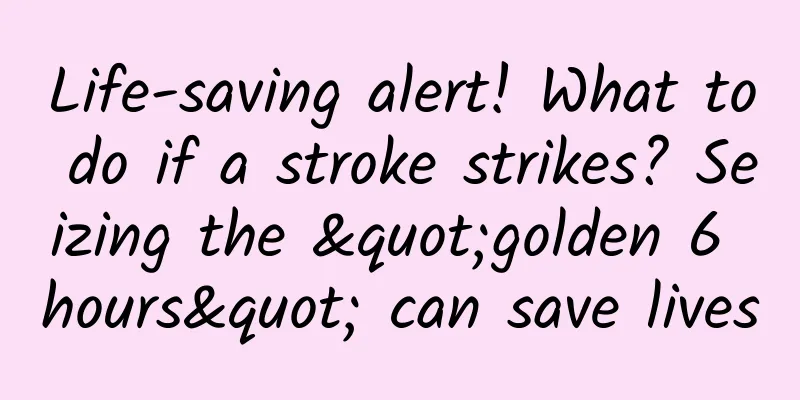Life-saving alert! What to do if a stroke strikes? Seizing the "golden 6 hours" can save lives

|
1. The importance of thrombolysis in the “life-or-death race” Yongzhou Fourth People's Hospital introduced that thrombolytic therapy is a key treatment measure after acute cerebral infarction. Cerebral infarction is caused by blockage of cerebral blood vessels, which leads to interruption of cerebral blood flow, thus causing ischemia and necrosis of brain tissue. The purpose of thrombolytic therapy is to restore cerebral blood perfusion in the shortest possible time and reduce brain tissue damage caused by ischemia. The shorter the time of thrombolysis, the more timely the patient's cerebral blood perfusion will be restored, the less brain tissue will be necrotic due to ischemia, and the patient will retain neurological function to the greatest extent, reducing the severity of sequelae. Best rescue time window: Thrombolysis within 3 hours leads to the best recovery and the least sequelae; Thrombolysis can still be achieved within 3-4.5 hours, but the effect is slightly reduced; If it lasts for more than 6 hours, a large number of brain cells will die, which may cause disability or even death. For every minute of delay, 1.9 million more brain cells die! If you delay for more than 6 hours, the risk of paralysis increases 10 times! 2. Why is it necessary to seek medical treatment nearby? 1. Time factor The treatment of cerebral infarction requires every second, so choosing a nearby hospital can shorten the time from onset to thrombolytic therapy and improve the success rate of treatment. 2. Medical capabilities At present, with the popularization of stroke emergency knowledge and the advancement of medical technology, many grassroots hospitals have sufficient and effective stroke treatment capabilities. These hospitals usually have advanced medical equipment and professional medical teams, and can provide patients with high-quality thrombolytic and thrombectomy services. 3. Practical Operation Suggestions 1. Understand the surrounding medical resources It is recommended that the public understand in advance the distribution of medical resources in their area and surrounding areas, including which hospitals have the ability to treat stroke, as well as the specific locations and contact information of these hospitals, etc. This way, decisions can be made quickly in an emergency and the most appropriate hospital can be selected for treatment. Sudden cerebral infarction, 3 steps to save life Step 1: Dial 120 immediately, key words Correct statement: "Someone here may have had a stroke! Symptoms are [crooked face/weak hands/slurred speech], address is Unit X, Building X, XX Community, XX Road, please send an ambulance as soon as possible!" Never say: "My family member is not feeling well, please come quickly" (this way emergency personnel cannot give priority!) Step 2: Learn the "FAST" rapid identification method (family members must learn it!) F (Face) : Smile and see if the corners of your mouth are crooked A (Arm) : Raise both arms horizontally and check if one side is weak and drooping S (Speech ): Speak a simple sentence, whether it is unclear T (Time) : If any symptom occurs, immediately write down the time of onset and call 120! Step 3: While waiting for the ambulance To do: Let the patient lie flat with the head tilted to one side (to prevent vomiting and choking); Loosen your collar and belt to keep breathing unobstructed; Record the time of onset (doctors must ask!); Prepare your medical insurance card, medical records, and regular medications. Don’ts: Feed water and medicine (may cause choking!); Pinching and slapping the philtrum (useless!); Hesitate and wait and see (cerebral infarction will not heal itself, delaying it will be fatal!). 2. Stay calm and call emergency services If someone is found to have symptoms of cerebral infarction, you should remain calm and immediately call the local emergency number (such as 120) to inform the patient's specific symptoms and location so that emergency personnel can respond quickly. 3. Cooperate with emergency personnel While waiting for the emergency personnel to arrive, you can try to keep the patient calm and avoid strenuous exercise or emotional fluctuations. At the same time, prepare the patient's relevant documents and medical history so that they can be treated quickly after arriving at the hospital. Source: Department of Neurology, Yongzhou Fourth People's Hospital Follow @湖南医聊 to get more health science information! (Edited by Wx) |
>>: My hands are swollen, is it because of washing hands?
Recommend
Why do you sweat easily during the confinement period?
It takes about 10 months for a woman to go from p...
White sharp wet picture
Genital warts are a disease that is highly transm...
What causes corpus luteum insufficiency?
Luteal insufficiency is a gynecological disease. ...
What should women do if they suffer from insomnia due to kidney deficiency? These foods are very effective
Nowadays, many women suffer from long-term insomn...
Does abnormal menstruation affect pregnancy?
Some women have irregular menstruation on a regul...
Percolate: Most companies start preparing social media marketing content a month in advance
199IT original compilation eMarketer predicts tha...
Vaginal discharge one week after hysterectomy
Hysterectomy is a common surgery in daily life an...
What is the last day of the year in 2020? Why can't we post Spring Festival couplets on the last day of the year?
When is the 2020 Jue Ri? Recently many people hav...
Itchy vagina with white stuff
For female friends, they must pay attention to pr...
Why do girls always have bruises on their bodies when they wake up?
"Honey, what did you do last night? Why is t...
Metronidazole tablets for the treatment of gynecological diseases
In daily life, gynecological inflammation caused ...
This disease has a poor prognosis and high mortality rate, and peritoneal dialysis patients need to pay attention!
Encapsulated peritoneal sclerosis (EPS) is a rare...
A new "co-suspension" triple drug is on the market. How should we choose among the various inhalation preparations?
COPD is one of the most common chronic respirator...
4 out of 10 people have this disease! It may induce myocardial infarction!
Four out of every ten people around us have hyper...
![[Medical Q&A] What are the dangers of “tooth loss”?](/upload/images/67f0e82776dc8.webp)








